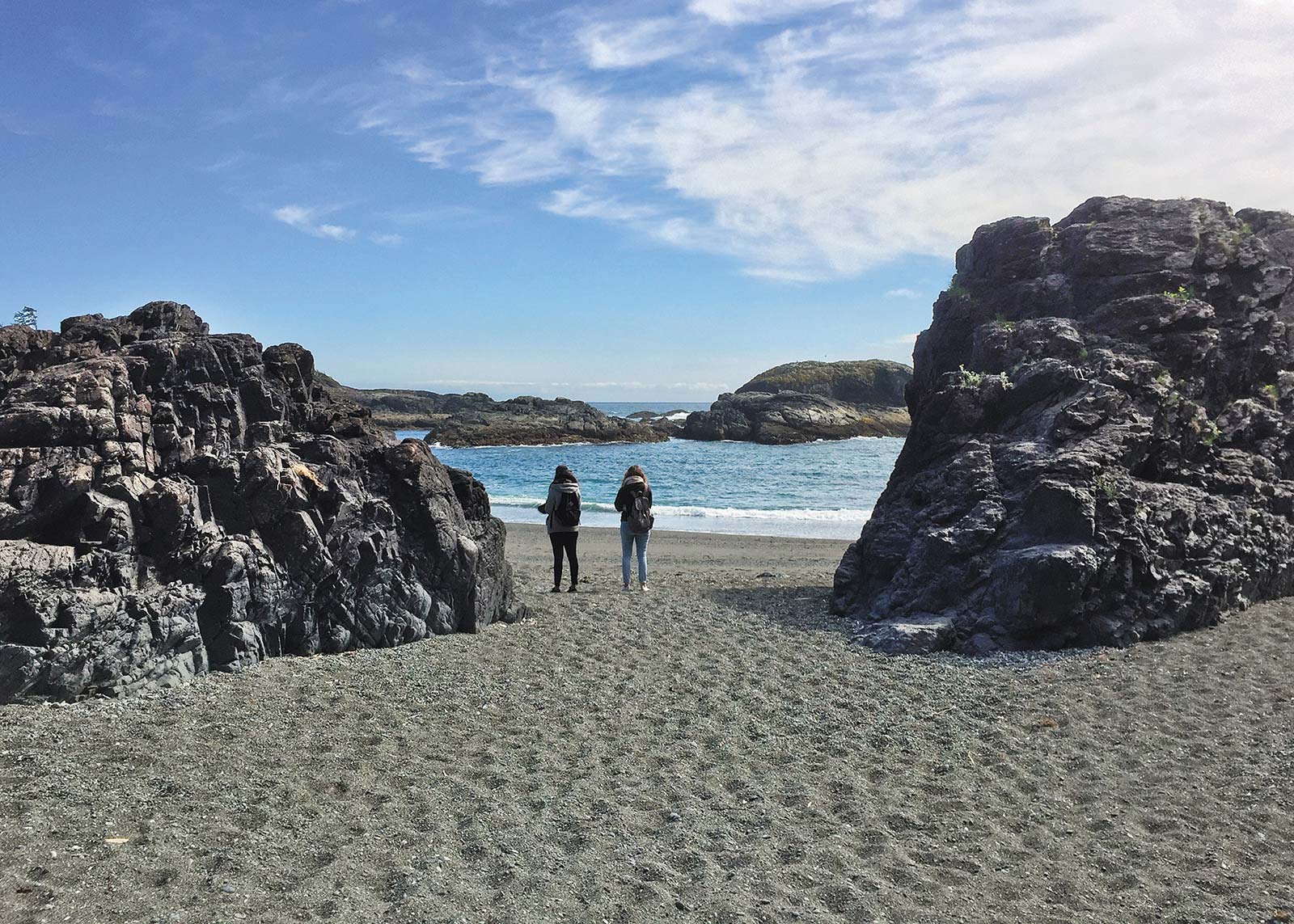
Snowy peaks, rushing rivers, and vineyard-lined valleys. Elaborate totem poles rising from the rainforest. Waterfront cities buzzing with outdoor cafés. Whales breaching and seals sunning just offshore. Clichés? Perhaps. But in Canada’s most naturally spectacular region, these clichés are true. Stretching from Vancouver to the Rockies, western Canada is tailor-made for a road trip.
In Vancouver, an active city bordering the mountains and the sea, begin your trip by strolling or cycling through a 1,000-acre (400-ha) rainforest park and exploring diverse cultures, from the original indigenous inhabitants to modern-day communities that reflect the city’s position on the Pacific Rim.
Across the Strait of Georgia on Vancouver Island, Victoria retains its British roots as it has morphed into a contemporary city. It’s now known as much for its locally produced wine, beer, and spirits as for its tradition of afternoon tea. Beyond Victoria, opportunities abound for exploring Vancouver Island’s forests, waterways, and dramatic coastal regions.
Back on the mainland, the Sea-to-Sky Highway is one of Canada’s most beautiful short drives, winding along the coast between Vancouver and Whistler. North America’s largest winter sports mecca, Whistler is busy in spring, summer, and fall, too, with hikers, cyclists, and other adventurers exploring the peaks and lakes.
Travel east from Vancouver to the sunny Okanagan Valley, with its string of freshwater lakes, orchards, and Canada’s only desert—and more than 200 wineries lining its back roads.
From the Okanagan, head to the Rocky Mountains. The Trans-Canada Highway passes through several of British Columbia’s mountain national parks, including Mount Revelstoke, Glacier, Yoho, and Kootenay, each more dramatic than the last.
Across the provincial border in Alberta are the marquee destinations of any western Canada road trip: Banff, Lake Louise, and Jasper. The region’s best scenic drive takes you along the Icefields Parkway, with its incredibly blue lakes and the largest area of glacial ice in the Canadian Rockies.

Once you’ve had your fill of hiking, rafting, and savoring the mountain vistas, continue on to the gateway city of Calgary, which not only hosts Canada’s biggest annual cowboy party but also offers distinctive museums and a pretty riverfront promenade. Or follow the southern route back toward Vancouver, exploring the Kootenays’ funky mountain towns and detouring along B.C.’s Hot Springs Highway.
From the ocean to the mountains, there’s plenty to experience, taste, and enjoy. Let’s hit the road.

The rainforest meets the city in Vancouver, where massive Stanley Park and forests of glass-and-steel skyscrapers populate the downtown peninsula. The North Shore mountains overlook the city skyline, while the sea hugs the city, with sandy beaches steps from urban hotels. Yet this outdoor-oriented metropolis has plenty of culture as well, reflecting its First Nations heritage (the totem poles at the Museum of Anthropology are a must-see) and its contemporary Pacific Rim society. Granville Island, Gastown, and Kitsilano draw food-lovers to their locally focused restaurants, while the suburb of Richmond has some of the best Chinese food outside China. With its well-connected international airport and location just north of the U.S. border, 145 miles (230 km) from Seattle, Vancouver is a convenient starting point for trips along the British Columbia coast and east to the Canadian Rockies.
Across the Strait of Georgia at the southern tip of Vancouver Island, British Columbia’s waterfront capital city of Victoria retains elements of its British heritage—visiting the world-class Butchart Gardens and taking afternoon tea at the grand Fairmont Empress are still beloved traditions for visitors—even as this increasingly cosmopolitan community booms with new restaurants, craft breweries, and cocktail bars. Elsewhere on the island, you can travel by boat to remote hot springs, take a bear-watching tour, or watch the waves crash along the Pacific coast.
One of western Canada’s most spectacular short drives, the Sea-to-Sky Highway connects Vancouver to the resort town of Whistler. Known for winter sports, Whistler has plenty to do in warmer weather, too, from riding the gondolas into the mountains, to hiking, cycling, and canoeing, to exploring the region’s indigenous heritage.
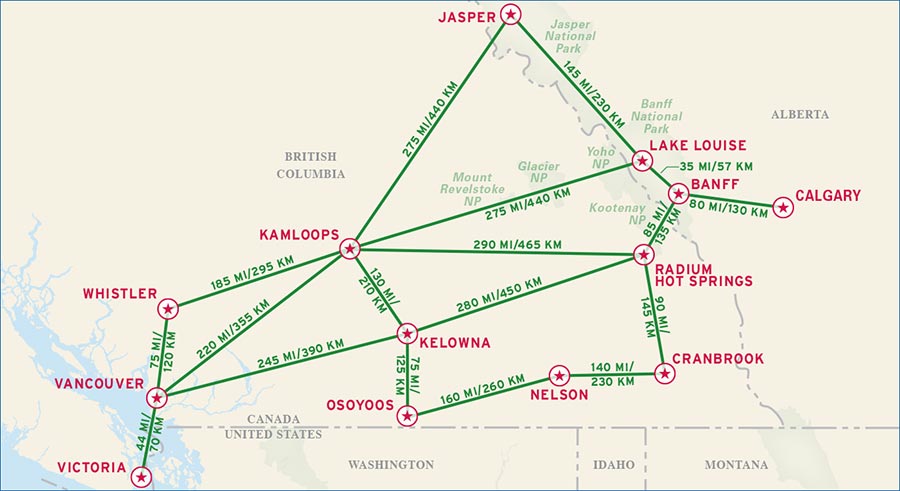

finding a quiet moment at Lake Louise

Victoria’s Inner Harbour.
As you drive east from Vancouver and cross the Coast Mountains, you leave behind the green coastal rainforest and wind through the desert-like hills of British Columbia’s interior. Here, the sunny city of Kamloops makes a convenient stopover point midway between Vancouver and the Rockies, with several small museums and an emerging wine industry. Continue east on the Trans-Canada Highway to a trio of national parks, Mount Revelstoke, Glacier, and Yoho, where you can hike, paddle the glacier-fed lakes, or enjoy the mountain scenery. Base yourself in towns like Revelstoke or Golden (only Yoho National Park has accommodations) and enjoy their cafés, restaurants, and comfortable lodgings.
Banff National Park is a highlight of any Canadian Rockies road trip, with dramatic mountain peaks and natural mineral pools, the sparkling blue Lake Louise, and more than 1,000 miles (1,600 km) of hiking paths. Within the boundaries of Canada’s first national park, the town of Banff bustles with restaurants, museums, and shops, and though its sidewalks can feel as jammed as New York City’s during the busy summer season, there’s plenty of space out on the trails.
The Icefields Parkway between Lake Louise and Jasper is one of Canada’s great drives, where you can stop at the Columbia Icefield to walk on a glacier or hike among the glacier-capped peaks. Without Banff’s crowds, Jasper National Park is equally beautiful, and as the largest park in the Canadian Rockies, there’s ample room to explore its lakes, canyons, and mountains.
The Kootenays region extends across southeastern British Columbia, between the Rocky Mountains and the Okanagan Valley. Here, you can explore the diverse landscape of Kootenay National Park, follow the Hot Springs Highway to several natural mineral pools, hang out in funky mountain towns like Fernie, Nelson, and Rossland, or learn more about the First Nations who’ve lived in the area for more than 10,000 years. Delve into the history of other communities, too, including the Japanese Canadians who were sent to internment camps across B.C. during World War II, and the Russian pacifists known as the Doukhobors who settled here in the early 20th century.
More than 200 wineries hug the lakeshores and rocky hills of the sunny Okanagan Valley in central B.C., often called the “Napa of the North.” This agricultural region stretches from Osoyoos, in the desert-like lands near the U.S. border, north to Kelowna, the area’s largest city. If you love wine, or enjoy being outdoors along some of Canada’s warmest lakes, stop in the Okanagan as you drive between Vancouver and the Rocky Mountains.
Canada’s fourth-largest city has the closest airport to the Canadian Rockies, so you can start or end your Rocky Mountain travels here. Known for the annual Calgary Stampede, Calgary has the excellent Glenbow Museum of western Canadian history, art, and culture; Heritage Park Historical Village, the country’s largest living history village; and the excellent National Music Centre. The city’s restaurants regularly rank among the country’s top dining spots. A short drive from Calgary, the Canadian Badlands has a completely different geological profile, with its unusual hoodoo rock formations and deep rocky canyons.

Canadian Badlands
High season in Vancouver and the Canadian Rockies runs May-October, when most attractions and roads are open and the weather is generally warm and sunny. July and August are the region’s peak travel months, with the sunny, temperate conditions balancing out the big crowds and high prices.
Ask the locals about the best time to visit the Canadian Rockies, though, and everyone will say September. The summer crowds begin to abate, the weather is still mild, and the trees take on their fall colors. Temperatures can remain pleasant into October, though the nights get colder, and snow frequently begins in late October or early November.
While the long days and fewer tourists make May and June a reasonable alternative for a Rockies trip, prepare for more rain than in the summer. You might have occasional damp days on the coast, but the Rockies can be hit with a “June monsoon,” when the rain turns heavy. These showers bring spring flowers, so pack a raincoat and get outdoors anyway.
Winter is mild in Vancouver and Victoria; rain is common November-March, but snow is unusual. As soon as you rise above coastal elevations, winter travelers should prepare for heavy snow. It snows a lot in the mountains of B.C. and in the Canadian Rockies, when severe weather can close highway mountain passes. Always check the forecast before you hit the road.
If you’re traveling in the summer, especially in July and August, book your hotel reservations in advance, particularly in Banff, Jasper, and Vancouver. Many of the national park campgrounds fill up early, so reserving a campsite for summer or holiday travel is also a smart idea. Car reservations are recommended on B.C. Ferries in the summer as well.
Visitors to Yoho National Park should note that two park activities require advance reservations and careful attention to the reservations procedure and deadlines: visiting Lake O’Hara and touring the Burgess Shale fossil beds. Refer to the Yoho National Park section for specifics.
On a two-week drive, you can road-trip from Vancouver to the Canadian Rockies and back, taking in many of western Canada’s top attractions. See Vancouver’s sights, then day-trip by ferry to Victoria, British Columbia’s capital. Take another day to get outdoors in the mountains at Whistler. Get ready for the real mountains, though, as you head east, stopping in Mount Revelstoke, Glacier, and Yoho National Parks as you enter the Canadian Rockies. In Alberta, you’ll visit Lake Louise, follow the scenic Icefields Parkway to Jasper, then return south for a couple of days outdoors in Banff National Park. From there, travel through B.C.’s Kootenays region, with stops in the fun towns of Fernie and Nelson, and go wine-tasting in the Okanagan Valley, on your way back to Vancouver and the coast.
You could also start and end the trip in Calgary, doing the loop in reverse.
Begin your tour in Vancouver, circling the scenic Seawall in Stanley Park, snacking on Granville Island, and getting an introduction to indigenous culture at the Museum of Anthropology. Explore Chinatown in the peaceful Dr. Sun Yat-Sen Classical Chinese Garden and in the neighborhood’s growing number of hip restaurants, or head to the North Shore to hike and enjoy the views from Grouse Mountain. With several beaches right downtown, wrap up your day with a sunset stroll along the sand.
Make a day trip to Vancouver Island today for a quick visit to Victoria. From Vancouver, drive south on Highway 99 to catch an early-morning B.C. Ferry from Tsawwassen; it’s a 90-minute trip to Swartz Bay. When you leave the ferry terminal, follow Highway 17A to the Butchart Gardens to wander among the floral displays.
From the gardens, take Keating Cross Road east to Highway 17 toward downtown Victoria. Park your car, then tour the Inner Harbour, have afternoon tea at the stately Fairmont Empress, and visit the Royal British Columbia Museum. Have a drink in one of the city’s craft breweries and dinner in a contemporary bistro, before returning to Swartz Bay for the ferry back to Vancouver.
Head north from Vancouver to pick up the Sea-to-Sky Highway (Hwy. 99), a scenic route between the mountains and the ocean that leads to the resort town of Whistler. Consider stopping in Squamish for a ride up the Sea-to-Sky Gondola; either have lunch with a view from the gondola summit or continue on to Whistler. Visit the excellent Audain Art Museum, learn more about local First Nations communities at the Squamish Lil’wat Cultural Centre, then get outdoors, whether you choose to ride the PEAK 2 PEAK Gondola, climb the Via Ferrata, go zip-lining, or simply take a hike.
Today is a long driving day as you set out for the mountains of eastern British Columbia. Leave Whistler on Highway 99 north to Highway 1 east; if you start early, you can reach Kamloops for lunch. Try to arrive at Mount Revelstoke National Park in time to zigzag up the Meadows in the Sky Parkway and take at least a short hike, before settling into the town of Revelstoke for dinner and a well-deserved rest.
After breakfast, make a brief stop at the Revelstoke Railway Museum to learn about the railroad’s importance to this region before continuing east on Highway 1 toward Glacier National Park. Stretch your legs on the Skunk Cabbage Boardwalk Trail or the Giant Cedars Boardwalk Trail (in Mount Revelstoke National Park) or on Glacier’s Hemlock Grove Trail before stopping at the Rogers Pass Discovery Centre. After checking out the exhibits, drive on to Golden for lunch; you could ride the gondola at Kicking Horse Mountain Resort to eat at the Eagle’s Eye Restaurant, Canada’s highest restaurant. Don’t forget to move your clocks ahead; Golden is in the mountain time zone.
Keep going east on Highway 1 into Yoho National Park. Stop at the Natural Bridge and beautiful Emerald Lake, and if you have time, drive up to Takakkaw Falls. Have dinner and spend the night at one of the upscale lodges within the park.
Today will be another long one, but keep your camera handy. You’ll pass through some of the most scenic terrain of the entire trip. It’s just 20 minutes east on Highway 1 from Field in Yoho National Park to Lake Louise, where you can hike or paddle along its famous namesake lake.
From Lake Louise, turn north onto Highway 93, the Icefields Parkway. There are numerous places to ooh and aah along this route; highlights include Peyto Lake, Wilcox Pass, and the Columbia Icefield, where you can walk on the Athabasca Glacier. Continuing toward Jasper, another pretty place to pause is Athabasca Falls. Arrive in Jasper for dinner and a microbrew in the local pub.
Start your morning with a ride up the Jasper Sky Tram. Return to town to pick up a picnic lunch and take a look through the Jasper-Yellowhead Museum. Bring your picnic to Maligne Canyon to hike through this deep limestone gorge.
In the afternoon, drive to Maligne Lake for a leisurely 90-minute cruise. Have an early supper in town, then head for Miette Hot Springs to wrap up your day with a relaxing visit to these natural mineral pools.
If you didn’t make all the stops you wanted along the Icefields Parkway, you have another chance today, since you’ll retrace your steps southbound on this picturesque parkway. When you get back to Lake Louise, detour to glacier-fed Moraine Lake for a short hike or canoe paddle. Then follow the Bow Valley Parkway south toward Banff, stopping to walk along Johnston Canyon. In Banff, have a leisurely dinner and a late-evening soak at Banff Upper Hot Springs.
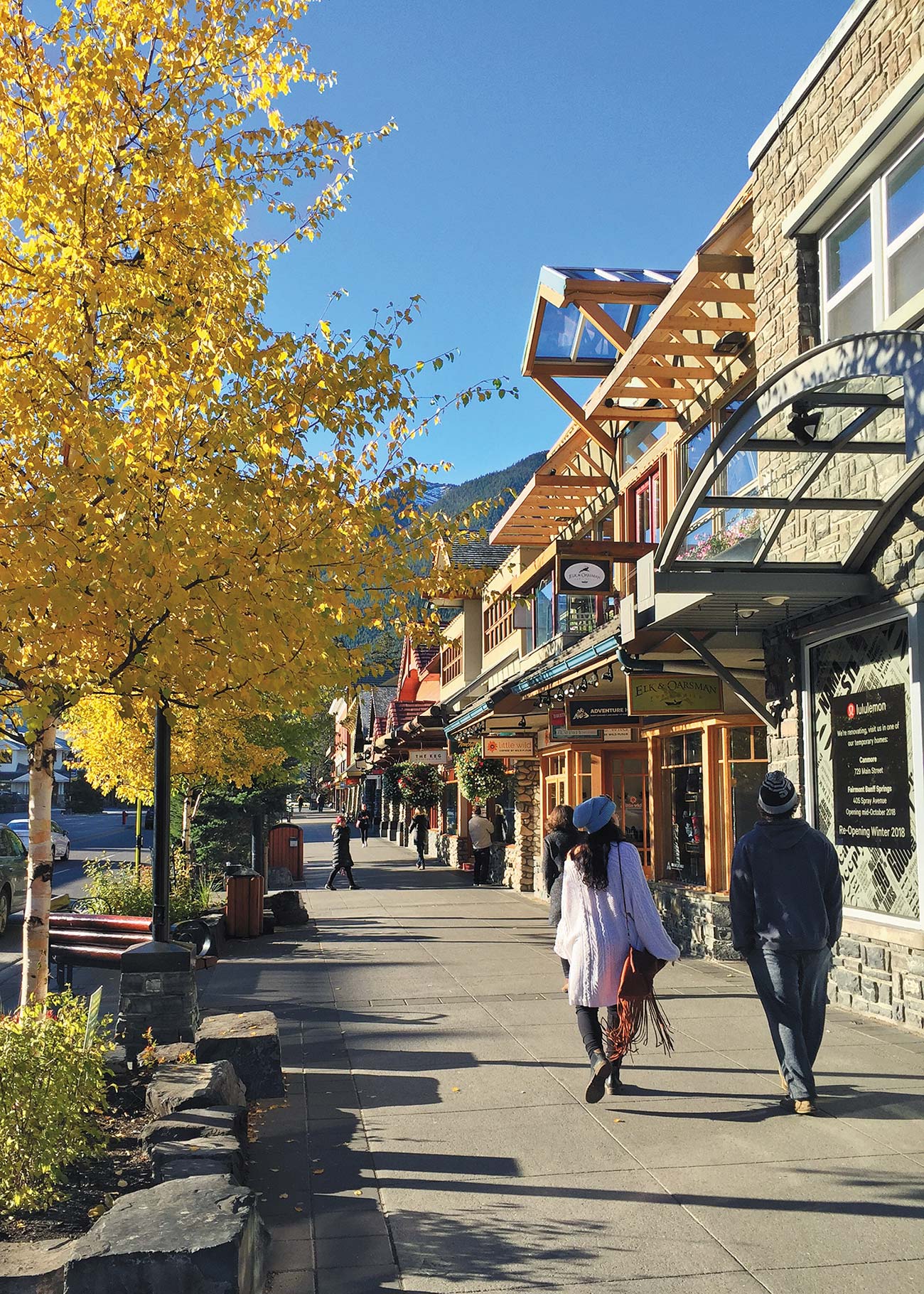
Banff Avenue

Emerald Lake Lodge in Yoho National Park.
Spend part of the next day at Banff’s in-town attractions, including the Cave and Basin National Historic Site, Banff Park Museum, and Whyte Museum of the Canadian Rockies, and part of the day outdoors. Climb the Mount Norquay Via Ferrata, take a cruise on Lake Minnewanka, or ride the Banff Gondola and take a short hike at the top. In the evening, see a play, concert, or other event at the Banff Centre.
Pick up coffee and pastries at Banff’s best bakeshop, Wild Flour Artisan Bakery. Then, leaving Banff, take Highway 1 west and turn south on Highway 93 into Kootenay National Park. Stop at Marble Canyon and the Paint Pots, and keep your bathing suit handy for a dip in the Radium Hot Springs. Continue south on Highway 93/95, where the town of Invermere has several options for lunch.
If you’re interested in history, stop at Fort Steele Heritage Town, a living history village. Keep following Highway 93/95 south and turn east on Highway 3 to Fernie, where you’ll spend the night. In the morning, check out the Fernie Museum, browse the downtown shops, and have lunch in one of the cafés. After you eat, head over to Fernie Alpine Resort to go for a mountaintop hike or to Island Lake Lodge to hike the lakeshore or explore the rainforest nearby.
Leave Fernie on Highway 3 west, stopping at St. Eugene Resort in Cranbrook to visit the First Nations-run Ktunaxa Interpretive Centre in this former mission and residential school for indigenous students; call first to be sure the center is open. Continue west on Highway 3, where you’ll cross back into the Pacific time zone (set your watch back an hour), to the junction with Highway 6, where you go north to Nelson.
Visit Touchstones Nelson: Museum of Art and History and browse the shops along Baker Street. Stop at Oso Negro Café when you’re ready for a coffee break. Another option is to tour the sobering Nikkei Internment Memorial Centre in New Denver, which is 60 miles (97 kilometers) north of Nelson on Highway 6. Nelson has lots of good restaurants, so take time to enjoy your evening meal.

Japanese garden at the Nikkei Internment Memorial Centre
From Nelson, follow Highway 6 west to Highway 3A south, and stop in Castlegar at the Doukhobor Discovery Centre to learn about the pacifist Russian community that settled in B.C. in the early 1900s. Then take Highway 3 west toward the Okanagan Valley.
You should arrive in the Osoyoos-Oliver area early enough to spend the afternoon sampling local wineries. Plan a special dinner at The Sonora Room at Burrowing Owl Estate Winery or Terrafina Restaurant at Hester Creek Winery to celebrate the end of your holiday.
If you’re not in a rush to return to Vancouver, pick up freshly baked cinnamon buns at The Lake Village Bakery in Osoyoos, then stop at the Nk’Mip Desert Cultural Centre or take a morning stroll along Lake Osoyoos. When you’re ready to hit the road, follow Highway 3 west to Hope, where you pick up Highway 1 toward Vancouver.
If you have just five days, base yourself in Vancouver for three nights, which is enough time to see the sights and take a day trip along the Sea-to-Sky Highway to Whistler. On Day 4, catch the ferry to Vancouver Island to tour Victoria; you can stay the night there—the city has lots of good restaurants and lodgings—before returning to Vancouver.
Have a little more time? Extend your trip for two or three days by crossing Vancouver Island to Tofino, a laid-back beach town on the Pacific coast.
If you want to spend your time in the Canadian Rockies and you have just a week, start and end your trip in Calgary. Do a quick city tour, and then head for Banff National Park, 90 minutes to the west. Spend two days in Banff to hike, canoe, or take a lake cruise, and check out the museums and shops in town. Drive west on Highway 1 to explore the highlights of Yoho National Park, then turn back east to Lake Louise, where you can stay near the famous lake.
From Lake Louise, allow at least half a day to drive the Icefields Parkway to Jasper; there are enough lakes, glaciers, and hiking trails to fill many hours. Give yourself two nights and at least one full day in Jasper National Park. Returning south, you’ll backtrack along the Icefields Parkway, but it will give you a chance to see any sights you missed. Spend one more night in Banff or stop off east of the park in Canmore, before returning to Calgary and heading for home.
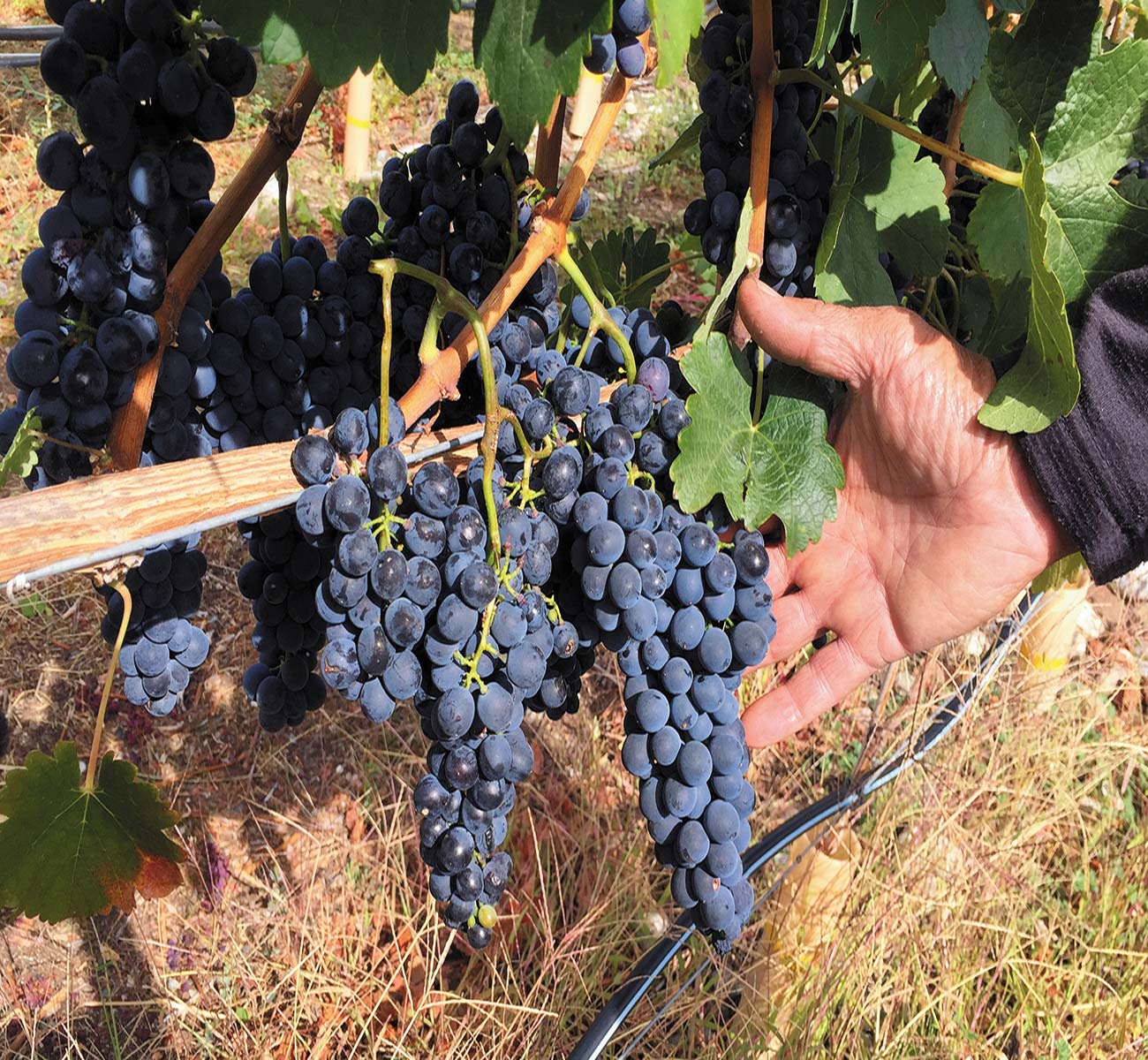
grapes on the vine in the Okanagan Valley
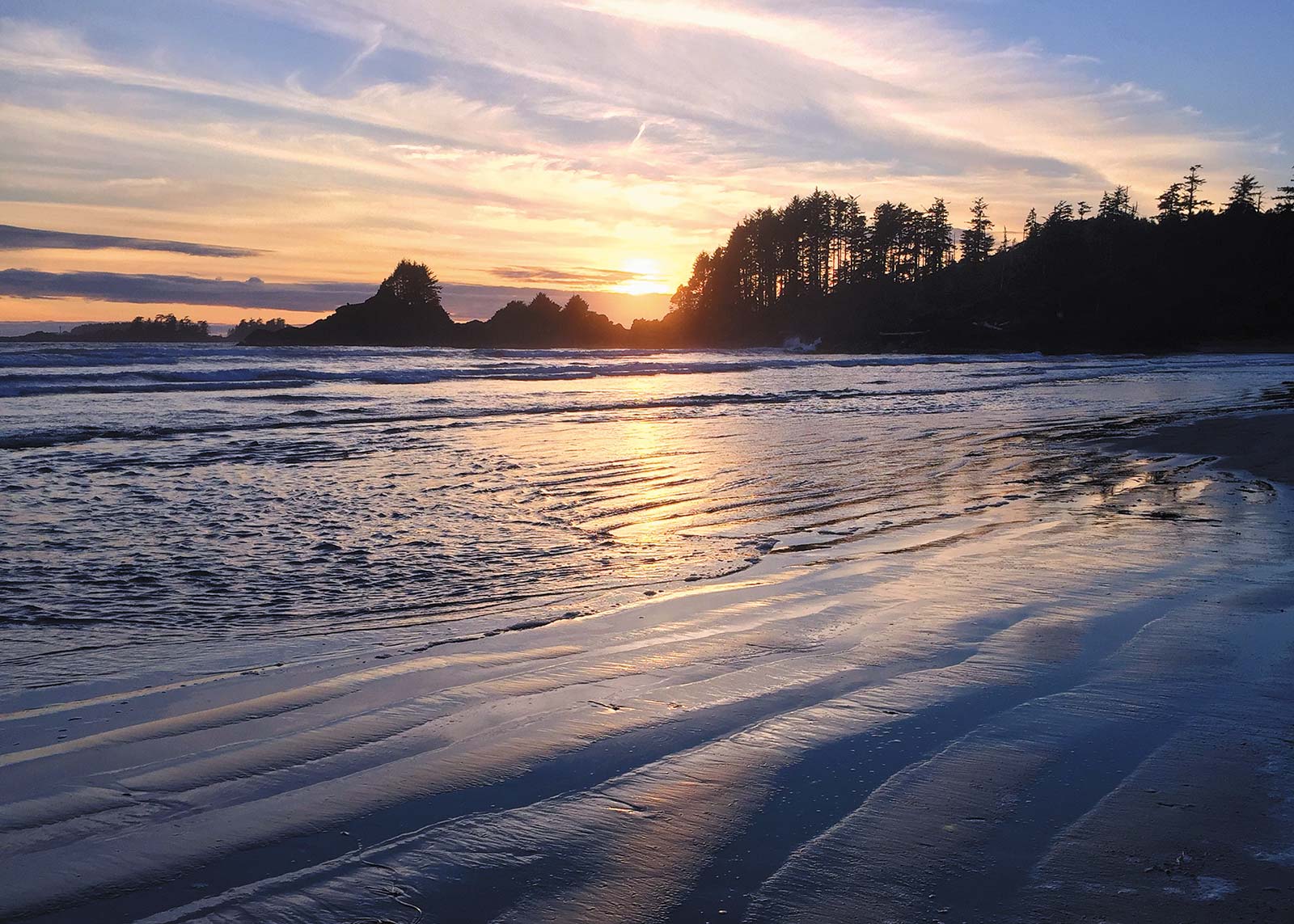
Tofino sunset.
If you don’t have time to make a full loop from Vancouver to the Canadian Rockies and back, consider starting in Vancouver and doing a one-way weeklong road trip to Calgary. To begin in Calgary and drive to Vancouver, just reverse the order of this itinerary.
After spending a couple of days in Vancouver, head east on the Trans-Canada Highway; at Hope, follow Highway 5 east, then take Highway 97A to Kelowna, where you can visit several Okanagan Valley wineries and stay the night.
The next day, continue east on Highway 1 to Mount Revelstoke and Glacier National Parks, and overnight in Golden. Explore Yoho National Park and cross into Alberta to stay at Lake Louise. Take the Bow Valley Parkway south to Banff, where you can easily spend two days in Banff National Park. From Banff, it’s only 90 minutes east on Highway 1 to Calgary.